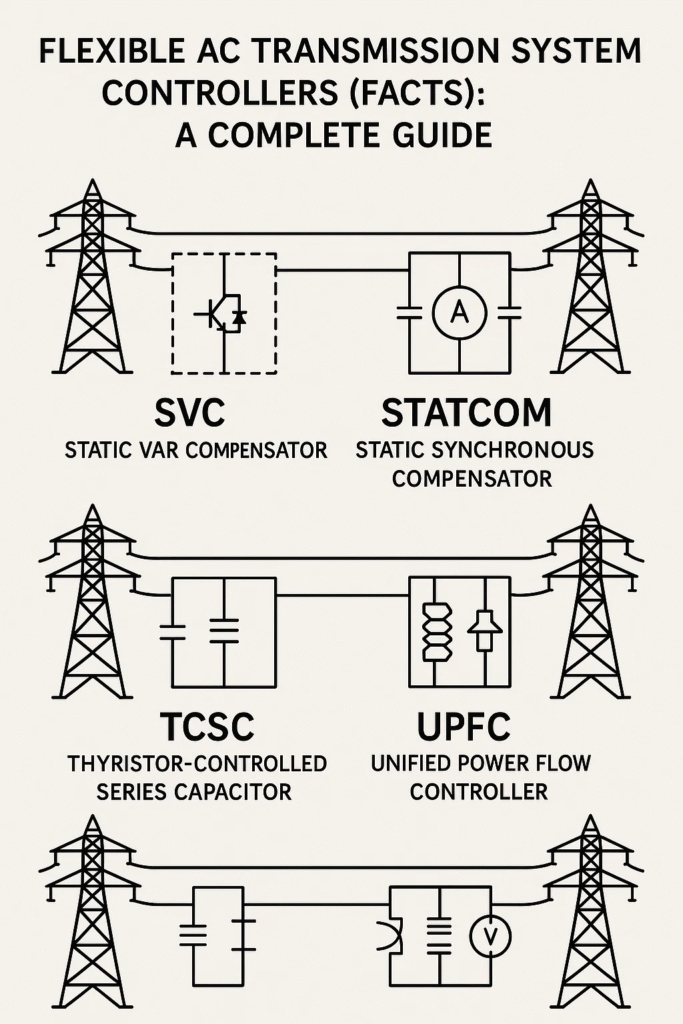🔍 Introduction
As global energy demand grows and renewable sources are combined at unprecedented rates, traditional power transmission infrastructure struggles to keep stride. Grid operators face challenges like bottlenecks, voltage instability, power flow mismanagement, and reliability concerns—especially during peak loads or faults.
Enter the world of Flexible AC Transmission Systems (FACTS)—an collaborative of advanced devices and technologies designed to enhance the controllability and capacity of power transmission networks. In this blog, we’ll explore the different types of FACTS controllers, their functions, modeling techniques, and real-world applications, all in straightforward, human-readable language.
What Are FACTS Controllers?
FACTS Controllers are power electronic systems combined into transmission lines to adjust electrical parameters dynamically and improve overall system performance. They enable faster control of:
– Power flow
– Voltage regulation
– Line impedance
– Stability enhancement
Instead of reinforcing infrastructure with expensive new lines, utilities can deploy FACTS devices to make smarter use of existing networks.
Classification of FACTS Controllers
FACTS controllers come in various forms, typically classified based on their installation location and functional role:
| Type | Description | Example Controllers |
| Series Controllers | Inserted in series with transmission lines | TCSC, SSSC |
| Shunt Controllers | Connected in parallel to transmission nodes | STATCOM, SVC |
| Combined Controllers | Feature both series and shunt elements | UPFC, IPFC |
Let’s explore each category in detail.
Series FACTS Controllers
Series controllers directly affect the impedance of transmission lines, influencing the power flow between points.
1. Thyristor Controlled Series Capacitor (TCSC)
– Uses thyristors to control capacitive reactance.
– Adjusts line impedance to manage power flow and oscillations.
– Useful in mitigating sub synchronous resonance and enhancing transient stability.
2. Static Synchronous Series Compensator (SSSC)
– Voltage source converter (VSC)-based device.
– Injects controllable voltage in series with the line.
– Offers dynamic control of power flow and damping of oscillations.
Shunt FACTS Controllers
Shunt controllers are connected at specific bulges and regulate voltage and reactive power levels.
3. Static Var Compensator (SVC)
– Combines fixed capacitors and thyristor-controlled reactors.
– Controls reactive power to steady voltage during load variations.
– Widely used in substations to prevent voltage collapse.
4. Static Synchronous Compensator (STATCOM)
– VSC-based, more advanced than SVC.
– Injects or absorbs reactive power rapidly.
– Effective during faults and renewable integration.
Combined FACTS Controllers
These devices are the power grid’s multitaskers—handling voltage, impedance, and angle together.
5. Unified Power Flow Controller (UPFC)
– One of the most versatile FACTS devices.
– Combines shunt and series converters.
– Controls power flow, voltage, and system stability simultaneously.
6. Interline Power Flow Controller (IPFC)
– Controls power flow across multiple lines in a corridor.
– Enhances load sharing and overall grid flexibility.
How FACTS Improve Power System Performance
FACTS controllers provide a wide array of benefits, including:
– Dynamic Voltage Support: During sudden load changes or faults.
– Enhanced Power Flow Control: Redirects power to underutilized lines.
– Stability Improvement: Damps oscillations and improves fault recovery.
– Increased Transmission Capacity: Without building new infrastructure.
– Renewable Energy Integration: Smooths voltage and frequency fluctuations.
These advantages make FACTS invaluable to both conventional and smart grids.
Modeling and Simulation Approaches
Modeling FACTS devices accurately is essential for planning and operational studies.
A. Steady-State Models
Used in power flow analysis:
– Represent FACTS as variable impedance or reactive power sources.
– Enable faster computation for planning studies.
– Tools: PSS®E, ETAP, Dexilant Power Factory.
B. Dynamic Models
Used in stability studies:
– Represent the control systems of FACTS devices.
– Simulate time-domain behavior during disturbances.
– Tools: MATLAB/Simulink, PSCAD/EMTDC.
C. Electromagnetic Transient Models
Used for fault, switching, and protection studies:
– Include switching dynamics, harmonics, and control logic.
– Required when studying detailed converter behavior.
Control Strategies in FACTS Devices
Effective control strategies ensure FACTS devices perform optimally under varying system conditions.

Control Features:
– PI and PID Controllers: Common in reactive power regulation.
– Fuzzy Logic & AI Algorithms: Adaptive control under uncertainty.
– Real-Time Monitoring via PMUs: FACTS devices use wide-area measurements for coordinated control.
Smart control schemes can improve response time, stability, and flexibility.
FACTS in Action: Real-World Applications
🇮🇳 India
Multiple STATCOM and SVC installations support high-voltage substations. TCSC enhances stability on long-distance corridors.
🇺🇸 United States
UPFC and SSSC devices address congestion and provide voltage support in thickly loaded regions like California and the Midwest.
🇹🇷 Turkey
FACTS play a role in mixing wind energy in Western Anatolia. STATCOM devices smooth grid voltage during variable generation.
Strategic Placement and Optimization
Where you place a FACTS device matters. Engineers use various methods to identify optimal locations:
– Sensitivity Analysis: Finds voltage weak spots or congested lines.
– Metaheuristic Algorithms: Genetic algorithms, particle swarm optimization (PSO), and ant colony optimization.
– Multi-objective Optimization: Balances cost, stability, and efficiency.
These strategies make FACTS investments more cost-effective and impactful.
Future Directions and Trends
The evolution of FACTS is closely tied to grid modernization and digital transformation.
– AI & Machine Learning-Based Control: Smarter, faster responses to grid events.
– Integration with Renewable Energy Systems: Stabilizing variable generation.
– Plug-and-Play Modular Devices: Easier deployment and maintenance.
– Cybersecurity in Power Electronics: Safeguarding control systems against threats.
Tomorrow’s grids will be more adaptive, resilient, and eco-friendly—thanks in part to FACTS.
Conclusion
FACTS controllers are the unacknowledged heroes of modern electrical grids. By enabling dynamic control of power flows, voltage rule, and stability enhancement, they help utilities achieve effective, reliable, and flexible operations. From the simple SVC to the powerful UPFC, each controller plays a critical role in shaping the future of electricity delivery.
Whether you’re a power engineer, researcher, or just inquisitive about how electricity gets from generation to your home, understanding FACTS is a gateway to the exciting border of smart grids and intelligent infrastructure.
